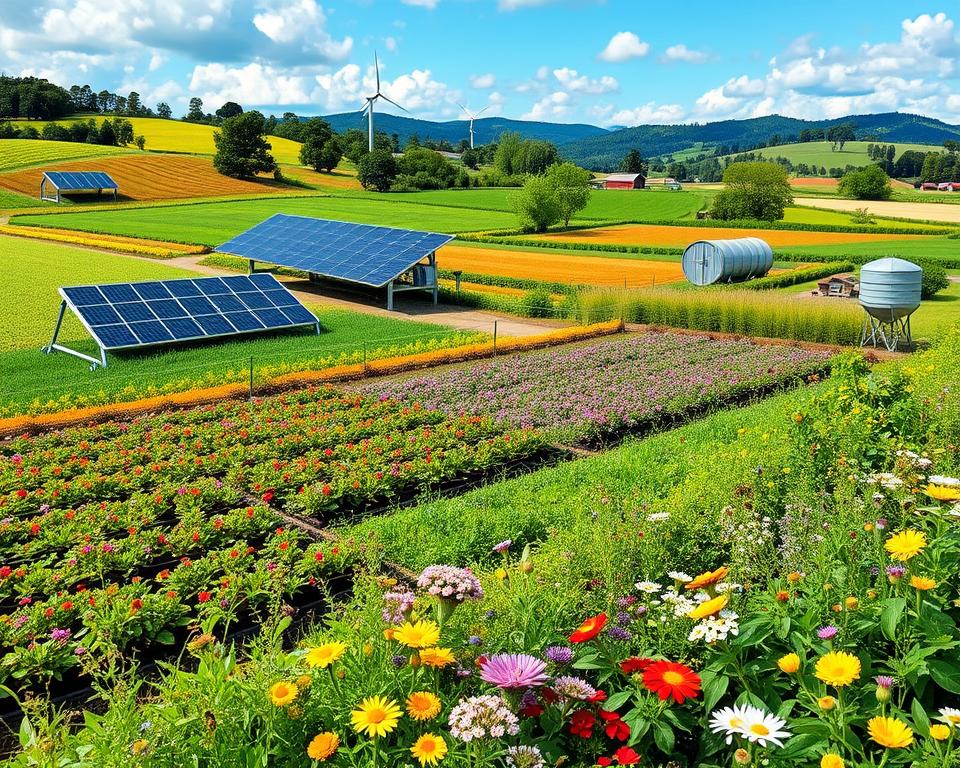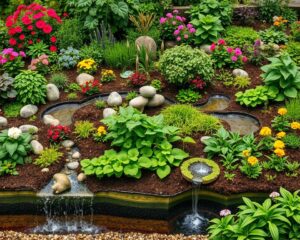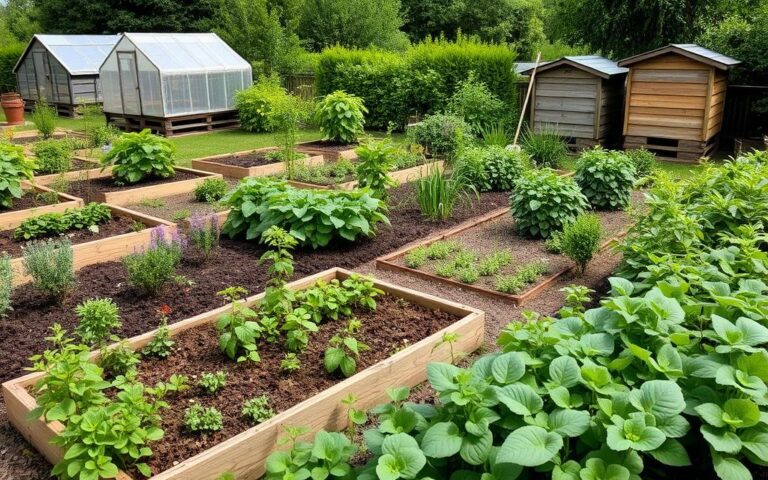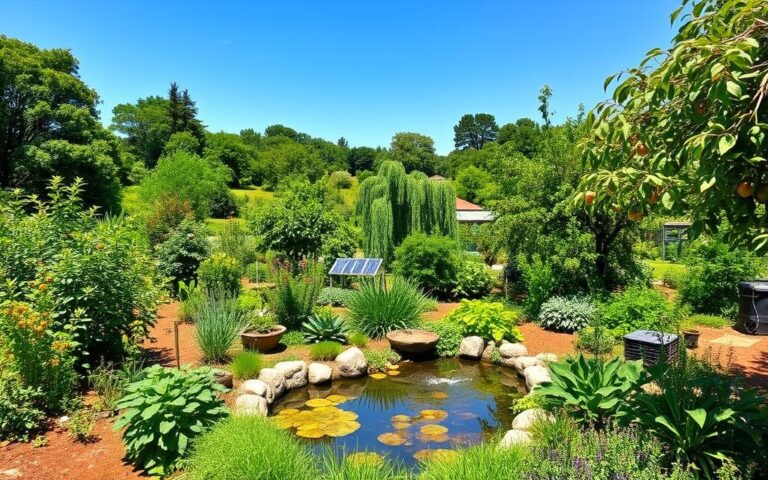Did you know a food forest can feed a family of four on just 1/10th of an acre? This shows the power of permaculture. It’s a way to live in harmony with the Earth. David Holmgren and Bill Mollison created twelve key principles for this approach.
These principles help us use eco-friendly farming everywhere. They work in different places and for all kinds of people.
In this article, we’ll look at the ten main principles of permaculture. We start with “Observe and Interact.” This principle is about making smart choices after careful watching. It’s the first step in your journey to sustainable farming.
These principles help us work better with our surroundings. They lead to a stronger and more fruitful environment.
Understanding Regenerative Practices in Permaculture
Regenerative practices are key in permaculture. They aim to improve and enhance ecosystem health. By using regenerative farming methods, you can make farming more sustainable and better for the planet.
What is Regenerative Agriculture?
Regenerative agriculture focuses on better soil health, more biodiversity, and caring for the environment. It uses organic methods like crop rotation, cover cropping, and no-till farming. This approach helps build strong ecosystems that can handle climate changes.
Benefits of Regenerative Practices
Regenerative practices offer many benefits. They improve food quality and make crops more resilient to bad weather. This approach also strengthens community bonds by encouraging everyone to care for the environment together.
Key Differences from Conventional Methods
Regenerative practices differ from traditional farming in many ways. Here’s a comparison to show the main differences:
| Aspect | Conventional Agriculture | Regenerative Agriculture |
|---|---|---|
| Soil Health | Often depleted, requiring synthetic inputs | Enhanced through natural practices like composting |
| Biodiversity | Typically low due to monoculture | Promotes high biodiversity through varied crops |
| Environmental Impact | Negative impact; soil degradation and pollution | Positive impact; supports ecological balance |
| Profitability | High input costs with variable returns | Lower costs and potential for high-value crops |
Principle 1: Observe and Interact
Observation is key to good design in eco-friendly farming. It helps you really see what’s around you. By noticing things like wind, sunlight, and local plants and animals, you can make your garden better.
This first rule is about getting to know your environment. It lets you plan smarter and use nature’s help. This way, you can grow more and help the planet at the same time.
The Importance of Observation
Many businesses don’t see how important it is to observe and interact. But, a lot of them fail because they don’t do this. By paying attention to your surroundings, you can do much better.
Things like money, direction, water flow, and weather are important for farming. Regenerative farming focuses on these to make ecosystems healthier.
Engaging with Your Environment
Being part of your environment is more than just knowing it’s there. Joining events like the Wilder.Work Day at Sitopia Farm on July 11th for £195 helps you get better at observing. It’s a chance to meet others who care about the planet.
By spending time on these activities, you help make a greener future. This future is one where farms are healthy and the environment is too.
Principle 2: Catch and Store Energy
This principle is about using natural energy sources to make systems strong. By using regenerative practices, you can catch and store energy. This helps make farming more sustainable in your area.
Solar Power in Permaculture
Solar energy is key in permaculture. Solar panels help make clean energy for everyday use. This cuts down on fossil fuel use and shows a dedication to green farming.
Adding solar solutions makes using resources better. It also matches the main goals of regenerative practices.
Water Harvesting Techniques
Good water management is crucial for a healthy permaculture. Rainwater collection is a big help. It keeps your garden watered when it’s dry.
This method is not just practical. It also helps create a better ecosystem. It shows how to farm in a way that’s good for the planet.
| Energy Source | Method | Benefits |
|---|---|---|
| Solar Power | Solar Panels | Renewable energy production, reduces fossil fuel dependence |
| Water | Rainwater Harvesting | Efficient irrigation, conservation of potable water |
| Firewood | Locally Sourced | Sustainable cooking, energy recycling |
| Food Energy | Leftovers for Composting | Reduces waste, enhances soil fertility |
Using these energy-capturing methods in your permaculture helps the environment. It also deepens your connection with nature. These actions show a smart way to manage resources, leading to a greener future.
Principle 3: Obtain a Yield
Getting a yield is key to success in permaculture. It’s about designing systems that give you both things you can see and feel. By using regenerative practices, your garden can give you many benefits that make your life better.
Creating Productive Systems
Building productive systems means picking plants that give you food, fiber, or fuel. Mixing annual and perennial plants can really increase your harvest. These systems use organic farming methods to keep your soil healthy and productive. Here are some important things to think about:
- Choose a variety of plants that thrive in your local climate.
- Incorporate perennials, which provide yields year after year.
- Focus on companion planting that supports plant health and maximizes space.
- Utilize efficient irrigation methods to enhance yields while conserving water.
Long-Term Sustainability
Using regenerative practices helps your garden and the environment last longer. Permaculture teaches us to see how everything is connected. This makes our gardens strong against changes in the environment. Here’s a table with key points for sustainable yield management:
| Aspect | Benefits |
|---|---|
| Diversity | Increases resilience to pests and diseases, promotes ecosystem stability. |
| Soil Health | Enhances nutrient availability and storage, improves water retention. |
| Renewable Resources | Reduces dependency on external inputs, supports sustainable yields. |
| Waste Reduction | Utilizes by-products effectively, minimizes environmental impact. |
Principle 4: Apply Self-Regulation and Accept Feedback
Understanding self-regulation and feedback is key in permaculture design. This principle helps you observe and learn from your environment. It builds a deeper connection with nature. Adjusting your methods based on what you observe leads to a more sustainable system.
Learning from Nature
Nature is a great teacher. Feedback loops help you see the effects of your actions over time. For example, the phrase “the sins of the fathers are visited unto the children of the seventh generation” shows how negative feedback can take time to show up.
Watching how your garden or farm reacts to different strategies gives you valuable insights. This helps you make better choices for the environment. Communities like Cedar Moon in Portland, Oregon, show how these principles can strengthen community bonds. They focus on social permaculture, leading to stronger connections among members.
Adjusting Your Practices
Being flexible in your practices is important for ongoing improvement. The story of Ava, Oliver, and Sandi fixing a bench shows the value of calm focus and attention to detail. This ensures quality work and fosters a culture of mutual support and learning.
Incorporating supervised ranging for chooks in a garden shows the balance between their benefits and potential damage. Some practices have immediate benefits, while others, like a 40-year-old mulberry tree, offer long-term protection against risks like fire. When challenges come up, remember that how you respond can shape your practices positively.
Involving children in outdoor learning, as in forest school, lets them explore risks and consequences. This helps them develop self-management skills for future resilience. Strategies like storing both preserved and fresh produce during abundant harvests promote self-reliance and adaptability, aligning with environmental stewardship.
Encouraging people to climb trees, as Sen and Kai did, helps them set and test their limits. Every successful experience, like the manual olive harvesting at Murrnong, shows teamwork and joy in the process. This makes people more engaged with regenerative practices.
| Example | Feedback Type | Outcome |
|---|---|---|
| Ava, Oliver, and Sandi repairing a bench | Positive feedback through quality craftsmanship | Enhanced community connections |
| Long-term growth of a mulberry tree | Delayed feedback from environmental protection | Reduced fire risk |
| Supervised chook ranging | Balance between benefit and damage | Healthier garden ecosystem |
| Children in forest school | Experiential learning | Improved self-management skills |
Principle 5: Use and Value Renewable Resources
Using renewable resources is key in permaculture. It means choosing local resources and eco-friendly farming. This helps our ecosystem stay healthy. It also supports the idea of regenerative agroecology, which values materials that can naturally replenish.
Benefits of Local Resources
Local resources have many benefits. They cut down on emissions, give us fresher food, and make communities stronger. Here are some main advantages:
- Lower environmental impact: Using local resources cuts down on carbon emissions from long trips.
- Enhanced community engagement: Buying from local farmers builds community and boosts local economies.
- Improved food quality: Food from nearby is often more nutritious than food that’s traveled far.
Incorporating Perennials
Adding perennial plants is smart for using resources well. They disturb the soil less and help ecosystems thrive. Here’s why:
- Soil health: Perennials improve soil, reducing erosion and boosting biodiversity.
- Efficiency: Perennials need less water and care than annuals once they’re set up.
- Year-round yield: Many perennials give us food for years, not just one season.

| Type of Resource | Benefit |
|---|---|
| Compost | Improves soil fertility and reduces waste. |
| Local Produce | Supports local economies and cuts carbon footprints. |
| Perennial Plants | Boosts biodiversity and lowers maintenance. |
| Renewable Energy | Lessens fossil fuel use and promotes green living. |
By adopting these practices in your permaculture, you build resilience. It also moves you closer to sustainable living. Valuing renewable resources is a big step toward a balanced, regenerative farm.
Principle 6: Produce No Waste
Producing no waste is key in sustainable agriculture and regenerative farming. It means every part of your garden has more than one use. This way, you boost productivity and help the environment.
Composting Strategies
Composting turns kitchen scraps and garden waste into something valuable. It makes the soil better and keeps organic materials out of landfills. In the UK, people throw away about 14.1 kg of food each week. Composting can cut down on this waste and give plants the nutrients they need.
Efficient Resource Use
Using resources wisely is crucial in regenerative farming. By reusing and recycling materials like paper and cardboard, you make your farm more sustainable. This approach shows how sustainable agriculture can be beneficial for your garden’s health.
Principle 7: Design from Patterns to Details
Designing from patterns to details is key in permaculture. It shows how understanding big ecological patterns helps make good designs. By watching nature’s rhythms, you can make better choices for your farm. This helps take care of the environment and builds sustainable ecosystems.
Recognizing Ecological Patterns
Seeing ecological patterns takes careful watching of the environment. Nature shows us patterns like spirals and waves. These patterns help us decide where to plant and how to use resources. It makes our land more productive and follows organic farming’s goals for growth and health.
Applying Patterns to Your Design
After spotting ecological patterns, it’s time to use them in your design. This means turning what you see into actions that make your space better. Here are some tips:
- Use perennial plants to make stable ecosystems that need less help over time.
- Plan layouts to get the most from sunlight, water, and nutrients based on your area.
- Add ways to reduce waste, like composting and catching rainwater, to save resources.
- Mix different plant types to make systems strong against diseases and pests.
Designing from patterns to details makes your environment stronger and self-sustaining. This way of thinking makes sure your actions meet today’s needs and help the environment in the long run.
Principle 8: Integrate Rather Than Separate
In permaculture, mixing different elements creates a thriving ecosystem. This principle teaches us to see how plants, animals, and other parts can work together. It shows how important it is to have a variety of life in our gardens.
Companion Planting Benefits
Companion planting is a great example of mixing things up. By placing plants that help each other, you can grow more and keep pests away. For example, tomatoes and basil together taste better and keep bugs off.
This method not only increases your harvest but also fits with the idea of using fewer chemicals. It’s a way to grow food that’s good for the planet.
Creating Biodiversity
Having a variety of plants in your garden is key to its health. It makes your garden strong and able to handle challenges. Different plants help the soil, fight off pests, and make nutrients available.
When you mix different species, you create a better environment. The more diverse your garden, the stronger it is against diseases and changes in the weather.
| Plant Pairing | Benefits | Regenerative Impact |
|---|---|---|
| Tomato & Basil | Improves flavor; repels pests | Enhances biodiversity |
| Carrots & Onions | Minimizes pests; maximizes space | Promotes healthy soil |
| Corn & Beans | Provides support; natural nitrogen fixation | Reduces fertilizer dependence |
| Squash & Radishes | Shade & weed suppression | Encourages soil coverage |
Principle 9: Use Small and Slow Solutions
Adopting small and slow solutions can change how you do permaculture. Choosing gradual steps helps the planet and keeps things sustainable. Smaller projects are easier to manage, letting you watch and adjust, leading to lasting success.
Advantages of Small-Scale Projects
Small projects have big benefits for your green journey. For example, using horses for farming instead of big machines helps the soil. Making compost at home is better than using chemicals for your soil.
Supporting local farmers’ markets helps your community and brings in more diverse food. These actions are good for the planet and for you.
- Encourages better soil health through slow adaptation.
- Allows for course corrections over time.
- Facilitates better observation of ecological outcomes.
Slower Systems for Stability
Nature works on a long-term plan, taking years or even centuries. Permaculture follows this slow pace for stability and strength. Using local seeds, for example, makes food systems more resilient.
Working together, like fixing natural springs or starting small gardens, makes a big difference. Events like permablitzes bring people together to create food gardens. This builds self-reliance in our communities.
Small steps in your life lead to a greener, more connected world. By caring for local ecosystems and learning old skills, we help the land and our communities. Small and slow solutions are key to lasting permaculture success.
| Aspect | Small and Slow Solutions | Traditional Large-Scale Approaches |
|---|---|---|
| Adaptation Time | Gradual adjustments over long periods | Immediate, but often unsustainable changes |
| Soil Health | Focus on organic practices; composting | Reliance on synthetic fertilizers |
| Community Involvement | Promotes collaboration and support | Often disconnected and individualistic |
| Resilience | Small systems can quickly adapt to changes | Big systems are vulnerable to disruptions |
Principle 10: Use and Value Diversity
Diversity is key to building strong ecosystems. By having many plants and animals, your garden becomes more stable and healthy. This supports sustainable farming.
Having different species helps fight pests and diseases. It also makes your garden more interesting.
Enhancing Resilience Through Diversity
A mix of crops and plants makes your garden strong. For example, regenerative pasture managers use over 80 plant species. This boosts ecological interactions and balances nutrient cycles.
Using different crops and plants, like Cosmos and Marigolds, attracts good bugs. These bugs help control pests. So, you use less chemicals and fight fewer infestations.
Crop Rotation and Variety
Crop rotation is crucial in regenerative farming. It keeps soil healthy and boosts production. Farmers moving from single crops see the benefits of planting hedgerows.
Hedgerows attract beneficial insects, reducing the need for chemicals. Having many plant types creates a lively and thriving garden.
Valuing diversity makes your garden and community stronger. Diverse skills help face challenges. By embracing diversity, you help create a sustainable future.
Conclusion: Embracing Permaculture in Your Life
Starting a permaculture journey can change your life for the better. Begin with small projects that fit your space and needs. This way, you can learn and grow slowly.
Before you start, analyze your site. Look at the soil, sunlight, and water. This helps make sure your projects are good for the planet.
Steps to Get Started
First, divide your garden into zones based on what it needs. Use companion planting to help plants grow well together. This boosts biodiversity and increases your harvest.
Find ways to save water, like collecting rain. This helps your plants grow strong. Also, focus on making your soil rich with compost and mulch. This makes your garden a healthy place for all living things.
Resources for Further Learning
To learn more about permaculture, check out books and workshops. They offer great tips and hands-on learning. Join groups that support eco-friendly farming to stay motivated.
With hard work and the right help, you can live a greener, more fulfilling life. Start your journey today and watch your garden grow.




